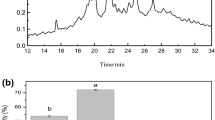Abstract
The aim of this work was to evaluate copper-chelating, iron-chelating and anticariogenic activity of peptides obtained by enzymatic hydrolysis of P. columbina protein concentrate and to study the effects of chelating peptides on iron bio-accessibility. Two hydrolyzates were obtained from P. columbina protein concentrate (PC) using two hydrolysis systems: alkaline protease (A) and alkaline protease + Flavourzyme (AF). FPLC gel filtration profile of PC shows a peak having molecular weight (MW) higher than 7000 Da (proteins). A and AF hydrolyzates had peptides with medium and low MW (1013 and 270 Da), respectively. Additionally, AF presented free amino acids with MW around 82 Da and higher content of His and Ser. Peptides from AF showed the highest chelating properties measured as copper-chelating activity (the lowest β-carotene oxidation rate: R o ; 0.7 min−1), iron-chelating activity (33 %), and phosphorous and Ca2+ release inhibition (87 and 81 %, respectively). These properties could indicate antioxidant properties, promotion of iron absorption and anticariogenic activity, respectively. In fact, hydrolyzates promoted iron dialyzability (≈16 %), values being higher than that found for P. columbina seaweed. Chelating peptides from both hydrolyzates can maintain the iron in a soluble and bio-accessible form after gastrointestinal digestion.
Similar content being viewed by others
Abbreviations
- PC:
-
Pyropia columbina protein concentrate
- A:
-
Hydrolyzate obtained with alkaline protease during 2 h
- AF:
-
Hydrolyzate obtained with alkaline protease 2 h + Flavourzyme 4 h
References
Harnedy P, Fitzgerald R (2011) Bioactive proteins, peptides and amino acids from macroalgae. J Phycol 47:218–232
Fan X, Bai L, Zhu L, Yang L, Zhang X (2014) Marine algae-derived bioactive peptides for human nutrition and health. J Agric Food Chem 62:9211–9222
Orsini Delgado M, Galleano M, Añón M, Tironi V (2015) Amaranth peptides from simulated gastrointestinal digestion: antioxidant activity against reactive species. Plant Foods Hum Nutr 70:27–34
Cian R, Martínez-Augustin O, Drago S (2012) Bioactive properties of peptides obtained by enzymatic hydrolysis from protein byproducts of Porphyra columbina. Food Res Int 49:364–372
Torres-Fuentes C, Alaiz M, Vioque J (2011) Affinity purification and characterization of chelating peptides from chickpea protein hydrolyzates. Food Chem 129:485–490
Zhu L, Glahn R, Yeung C, Miller D (2006) Iron uptake by caco-2 cells from NaFeEDTA and FeSO4: effects of ascorbic acid, pH, and a Fe(II) chelating agent. J Agric Food Chem 54:7924–7928
Bernardi C, Drago SR, Sánchez H, Freyre (2006) Formulation and sensory evaluation of Prosopis alba (Algarrobo) pulp cookies with increased iron and calcium dialyzabilities. Plant Foods Hum Nutr 61:37–42
Cross K, Huq L, Reynolds E (2007) Casein phosphopeptides in oral health-chemistry and clinical applications. Curr Pharm Des 13:793–800
Aimutis W (2004) Bioactive properties of milk proteins with particular focus on anticariogenesis. J Nutr 134:989–995
Cian R, Garzón A, Betancur-Ancona D, Chel-Guerrero L, Drago S (2015) Hydrolyzates from Pyropia columbina seaweed have antiplatelet aggregation, antioxidant and ACE I inhibitory peptides which maintain bioactivity after simulated gastrointestinal digestion. LWT Food Sci Technol 64:881–888. doi:10.1016/j.lwt.2015.06.043
Cian R, Salgado P, Drago S, González R, Mauri A (2014) Development of naturally activated edible films with antioxidant properties prepared from red seaweed Porphyra columbina biopolymers. Food Chem 146:6–14
Nielsen P, Petersen D, Dambmann C (2001) Improved method for determining food protein degree of hydrolysis. J Food Sci 66:642–646
AOAC (1995) Official methods of analysis, 16th edn. Horowitz, Washigton DC
Alaiz M, Navarro J, Giron J, Vioque E (1992) Amino acid analysis by high-performanceliquid chromatography after derivatization with diethylethoxymethylenemalonate. J Chromatogr A 591:181–186
Yust M, Pedroche J, Girón-Calle J, Vioque J, Millán F, Alaiz M (2004) Determination of tryptophan by high-performance liquid chromatography of alkaline hydrolyzates with spectrophotometric detection. Food Chem 85:317–320
Megías C, Pedroche J, Yust M, Girón-Calle J, Alaiz M, Millán F, Vioque J (2008) Production of copper-chelating peptides after hydrolysis of sunflower proteins with pepsin and pancreatin. LWT Food Sci Technol 41:1973–1977. doi:10.1016/j.lwt.2007.11.010
Itoh A, Ueno K (1970) Evaluation of 2-hydroxy-1-(2-hydroxy-4-sulpho-1-naphthylazo)-3-naphthoic acid and hydroxynaphthol blue as metallochromic indicators in the EDTA titration of calcium. Analyst 95:583
Warner E, Kanekanian A, Andrews A (2001) Bioactivity of milk proteins: 1. Anticariogenicity of whey proteins. Int J Dairy Technol 54:151–153
Miller D, Schricker B, Rasmussen R, Van Campen D (1981) An in vitro method for estimation of iron availability from meals. Am J Clin Nutr 34:2248–2256
Drago S, Binaghi M, Valencia M (2005) Effect of gastric digestion pH on iron, zinc and calcium availability from preterm and term starting infant formulas. Food Sci 70:107–112
Chang C, Wu K, Chiang S (2007) Antioxidant properties and protein compositions of porcine haemoglobin hydrolyzates. Food Chem 100:1537–1543
Fleurence J (1999) Seaweed proteins: biochemical, nutritional aspects and potential uses. Trends Food Sci Technol 10:25–28
Guo L, Hou H, Li B, Zhang Z, Wang S, Zhao X (2013) Preparation, isolation and identification of iron-chelating peptides derived from Alaska pollock skin. Process Biochem 48:988–993
Wang C, Li B, Ao J (2012) Separation and identification of zinc-chelating peptides from sesame protein hydrolysate using IMAC-Zn2+ and LC–MS/MS. Food Chem 134:1231–1238
Adamson N, Reynolds E (1995) Characterization of multiply phosphorylated peptides selectively precipitated from a pancreatic casein digest. J Dairy Sci 78:2653–2659
Cian RE, Fajardo MA, Alaiz M, Vioque J, González RJ, Drago S (2014) Chemical composition, nutritional and antioxidant properties of the red edible seaweed Porphyra columbina. Int J Food Sci Nutr 65:299–305
Acknowledgments
The authors are thankful to CAI + D 2011 PI 0292 LI and PRODEP-SEP: Hydrolyzates and Bioactive Peptides network for the financial support.
Author information
Authors and Affiliations
Corresponding author
Ethics declarations
Conflict of Interest
The authors declare no conflicts of interest.
Human and Animal Rights
This article does not contain any studies with human or animal subjects.
Rights and permissions
About this article
Cite this article
Cian, R.E., Garzón, A.G., Ancona, D.B. et al. Chelating Properties of Peptides from Red Seaweed Pyropia columbina and Its Effect on Iron Bio-Accessibility. Plant Foods Hum Nutr 71, 96–101 (2016). https://doi.org/10.1007/s11130-016-0533-x
Published:
Issue Date:
DOI: https://doi.org/10.1007/s11130-016-0533-x




